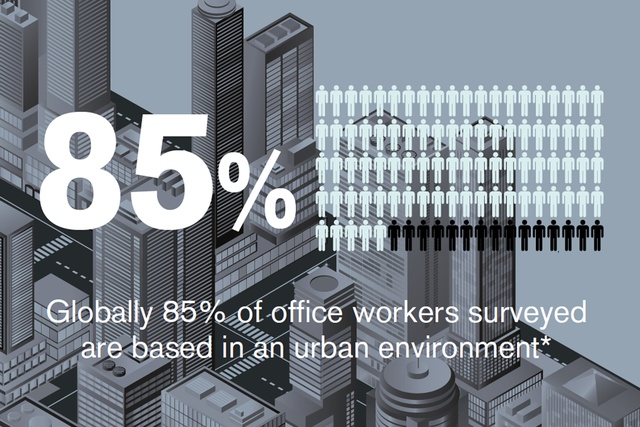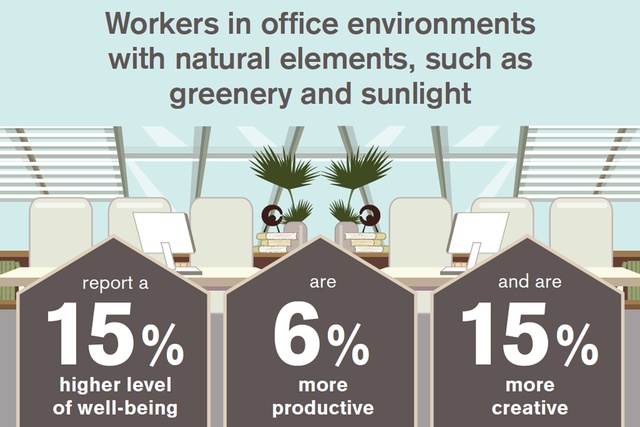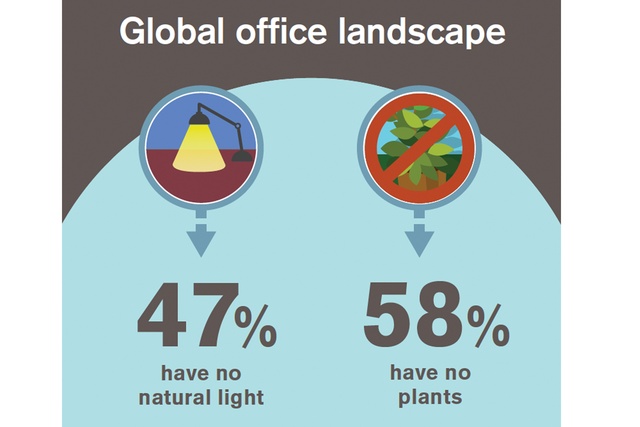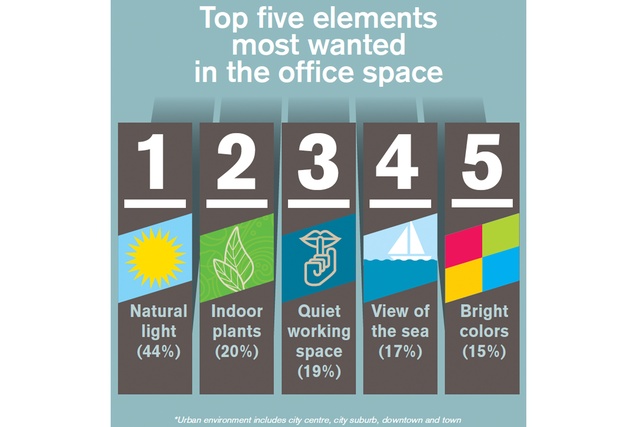The global impact of biophilic design in the workplace
Partner Content: An Interface research study on the relationship between psychological well-being, work environments and employee expectations.
Should a ‘work’ place be any different from the other spaces people inhabit? The relationship between individuals and their environment can be a crucial determinant of how they feel, perform and interact with others. So, designing spaces that inspire, energize and support the people who use them is a global imperative.
RESEARCH COLLABORATORS:

People’s connection to nature – biophilia – is an emergent field that can help organizations meet that challenge. This unique study explores the relationship between psychological well-being, work environments and employee expectations on a global scale for the first time. Biophilia, a concept first popularized by Edward O. Wilson in 19841, describes the innate relationship between humans and nature, and concerns the need we have to be continually connected to nature. Plenty of research confirms this human preference for the natural, rather than built, environment2. For example, in a 2004 study, when asked to describe their ideal city, people more often chose non-urban characteristics, greenery in particular3, and in other studies it has been shown that a pleasant and natural view can raise the price of a house considerably4.
Although it has been proposed that this desire for a connection with nature is the result of an anti-urban bias combined with a romantic view of nature, environmental psychology research tells us that being connected to nature, is in fact, an adaptive human function that allows for, and assists with, psychological restoration5.
This means that within an urbanized environment, bringing in elements that allow direct nature connection (such as parks and lakes) or indirect connections (i.e., interior design using natural elements, nature-resembling colours and patterns, indoor plants and views of greenery) can help us to mentally recover and provide respite from our day-to-day activities, to maintain positive well-being.
Interest in biophilia has grown substantially over the last decade, largely due to the rapid urbaniziation of the modern world, which has resulted in cities that are characterized by a predominance of manmade structures. Global figures show this incredible shift in populations moving into urban areas over the last 60 years.
Some countries, including those we have analyzed in this report, have seen an increase of over 40% in the number of individuals in the population residing in urban areas since 1950. In particular, those countries that have seen the greatest economic development in recent years appear to be the nations with the greatest increase in urbanization such as Brazil (51%), Indonesia (42%), the Philippines (39%) and China (32%).
Globally, it is clear that people are moving away from rural areas to towns and cities. In fact, the United Nations predicts that by 2030, 60% of the world’s population will live in urban environments. Therefore, it is imperative that we consider how the human-nature connection can still be provided to those residing in towns and cities. The answer to this challenge is biophilic design.

Often, we find that our cities and suburbs have been designed in a way that alienates us from nature and degrades the environment. Biophilic design is a method of designing the places in which we live and work in such a way that satisfies our deep and fundamental need to be connected with nature.
The effects of providing this connection to nature go much further than simple employee satisfaction. An increasing research base has identified the positive benefits of biophilic design in supporting multiple organisational outcomes, including well-being, productivity and creativity.
The focus of this report is on the potential benefits to be gained by satisfying humans’ biophilic needs in the workplace, as well as the issues that surround working in environments that do not provide a connection with the natural world. Following an EMEA (Europe, Middle East & Africa) Human Spaces report published in 2014, which analyzed original data across eight countries in the region and looked specifically at the impact of biophilic design in that geographical area, a second wave of data collection has provided the base for a global research project.
Collecting data from 16 countries around the world, this research quantifies the benefits of biophilic design in the workplace. While adding to the existing evidence base for biophilic design, we aim to provide a blueprint for nature-inspired design for high-performing organisations.
THE IMPACT OF BIOPHILIA
1. Wellbeing
A key factor in maintaining positive well-being is reducing levels of stress. Research has identified that visible connections to nature can have a positive effect on an individual’s reported stress levels. In a review of numerous studies looking at the effects of different landscapes on health, it was found that natural landscapes had a more positive effect compared to urban landscapes6.
In fact, in some cases, urban landscapes had a negative effect. According to our findings, this is certainly the case in France, where views of natural scenes such as greenery, wildlife and even ocean views were linked to the greatest levels of well-being among office workers and window views of urban scenes, such as roads and buildings were linked to a lower sense of well-being.
Our data shows that, in Canada, the provision of green space is important in ensuring that workers’ well-being is at a positive level. This is supported in recent empirical research that looked at the associations between well-being and nature connectedness among a student population. Significant associations emerged, showing that when people were connected to nature in both their internal and external environment, they reported much greater levels of well-being7.
Our analysis has shown that perceptions of well-being can increase by up to 15% when people work in surroundings that incorporate natural elements, providing that connection to nature, in contrast to those who have no contact to nature in their workplace. An increase of this size is certainly significant with such a large sample that is representative of the global population. For well-being to increase this dramatically is evidence of the power of biophilic design in the workplace and the positive impact that this can have on employees.
GLOBAL RESEARCH FINDINGS
Natural elements positively linked to well-being at work:
- Nature views: Having no window view was significantly related to greater levels of reported stress. In contrast, window views of greenery and water were linked with lower levels of stress.
- Accent colours: Employee well-being is positively impacted by offices that incorporate nature-resembling colours such as green, blue and brown. It was also found that the use of gray colours within the workspace had a significant negative impact on employees’ levels of stress.
- Nature within the workspace: Across the world, those who work in offices that provide natural light, live plants and greenery along with water features, report significantly higher levels of well-being than those who work in environments devoid of nature.
- Light and spacious workspaces: Those who report that their work environment provides a sense of light and space report greater levels of well-being in comparison to those who do not feel that their work environment is light and spacious.

2. Productivity
Feeling good often equates to being able to do more. In addition to the abundance of research that confirms the relationship between well-being and productivity8 there is also clear evidence directly linking biophilia with an organisation’s output.
One of the more recent, and most relevant, research studies looking at these effects was carried out in the UK (a study called ‘The relative benefits of green versus lean office space: Three field experiments’9), where university researchers in Cardiff compared the levels of productivity of two groups of office workers who were exposed to different levels of nature contact. They found that those who worked in offices with natural greenery saw a 15% rise in productivity over a three month period, in comparison to those working with no greenery or natural elements within their immediate environment.
GLOBAL RESEARCH FINDINGS
For the first time, this research is showing universal links between productivity and office design. Despite the various cultural differences surrounding work and workspaces across the 16 countries that contributed respondents to the survey, the following elements were positively linked to productivity in all cases. They present a template for biophilic design in the workplace, which can be further tailored to match an organisation’s unique context.
Natural elements positively linked to productivity at work:
- Nature views: Viewing external nature scenes from the office space had a positive impact on workers’ productivity.
- Accent colours: Colours such as blue, green and yellow were associated with higher levels of productivity.
- Nature within the workspace: Ensuring the presence of natural elements within the workplace, such as plants, green space, plenty of light and elements of water predicted greater levels of productivity.
3. Creativity
The impact of biophilic design on the individual’s ability to act, behave and perform creatively within the context of their role is something that has received less focus within the realm of research into biophilic design. The analysis of the global data sample revealed that a worker’s creativity can be strongly influenced by their surrounding environment and the extent to which this incorporates natural elements.
More specifically, we found that for those working in environments that incorporate these natural elements, such as daylight and live plants, reported levels of creativity are 15% higher than the levels reported by those who work in environments devoid of nature.
Again, this highlights an important consideration for employers and designers to think about how they can incorporate aspects of biophilic design into the work environment that they are either creating or providing.
GLOBAL RESEARCH FINDINGS
Natural elements positively linked to creativity at work:
- Nature views: Having no window had a significant negative effect on employee creativity.
- Colours: Gray offices were associated with lower levels of employee creativity. Bright colours like yellow, blue and green were beneficial in promoting creativity.
- Nature within the workspace: Natural elements in the office space had a positive effect on levels of creativity.
SUMMARY
The science supporting biophilic design is still developing. However, some may say that this field of research is really just a re-emergence of what people have known for centuries – humans have an innate affinity for, and a deep connection with, the natural environment.
Throughout this report, the benefits of providing workers with access to nature-inspired elements in the workplace have been justified. Yet despite this, the global research we have engaged in shows a vast deficiency in the provision of even the most basic biophilic needs, such as natural light and views of nature.
It is likely that for some organisations, providing natural light and window views may not be feasible within the constraints of their current building design. Yet there are ways of mimicking nature indoors and arranging the office that can still deliver the same benefits as the real thing. Research has shown that effectively re-creating nature indoors can reduce stress and restore energy levels with the same degree of impact asreal contact with nature10. However, it is still important to note that real living nature contact results in significantly stronger physiological responses than simulated nature (Kahn et al., 2008)11.

In their article on the 14 Patterns of Biophilic Design, Browning, Ryan & Clancy12 describe a non-visual connection with nature as one of the ways in which humans’ biophilic needs can be met. They note that a space with a good non-visual connection with nature feels fresh and balanced - the space should provide complexity and variability as well as being familiar and comfortable. Additionally, by providing sounds, aromas and textures that are reminiscent of being outdoors, we are able to provide a symbolic connection to nature. This is backed by research13 showing that following exposure to a stressor, nature sounds can accelerate psychological restoration by up to 37%.
Ultimately, the research in this area indicates that bringing elements of nature into the workplace, whether real or artificial, provides positive effects on employee outcomes. As such, when thinking about office design and its impact on employees, employers should take serious consideration of the amount of nature contact provided in the workspace in order to both maintain positive levels of well-being among employees and keep employee performance at optimal levels. Specifically, our research has shown that various nature elements can have a positive impact on the individual employee and the most important of these globally tend to be the provision of natural light, a window and greenery within the office space.
The Human Spaces global research study has shown that indeed there are many benefits to providing this nature contact. To not provide it may be potentially damaging to organizations. Many respondents, a third (33%) in fact, reported that they would be affected by workplace design when choosing to work for a company. This emphasizes how an individual’s surrounding environment can directly influence how they feel about the organization which will inevitably influence their feelings and behaviors when they are working.
Finally, it is important to note the impact of culture in the realm of workplace biophilic design. The global nature of this study has allowed a broad range of countries and regions across the globe to be investigated and analyzed in terms of employee preferences for biophilic design and how elements of this design may have differing impacts on various employee outcomes. It has been clearly demonstrated that cultural differences do exist, suggesting that these preferences may even be found at the organizational or individual level. Therefore, it is crucial for organizations and designers to carefully consider these differences in order to ensure that the work environment they create is optimal for a high-performing, happy and healthy workforce.
Key Themes Across Countries:
- Natural light was a crucial determinant of all three employee outcomes – well-being, productivity and creativity.
- Most commonly, it was views of greenery, water and wildlife that had the strongest impact upon these factors.
- Having no window view was frequently predictive of lower levels of creativity.
- Office colour schemes that incorporated accents of green, blue and brown were more predictive of employee happiness, productivity and creativity than blank white walls. However, the particular colours associated with these outcomes appear to differ between countries.

KEY MESSAGES
1. It is clear that biophilic design in the workplace has a strong, measurable impact on key employee outcomes such as well-being, productivity, creativity:
- Those who work in environments with natural elements, such as greenery and sunlight, report a 15% higher level of well-being than those who work in environments devoid of nature.
- Those who work in environments with natural elements, such as greenery and sunlight, report a 6% higher level of productivity than those who do not have the same connection to nature within their workspace.
- Those who work in environments with natural elements, such as greenery and sunlight, report a 15% higher level of creativity than those with no connection to natural elements in the workplace.
2. Across the world, a third of all respondents report that the design of an office would affect their decision to work for that organization, presenting biophilic design as an important consideration for those companies that want to attract and recruit the best employees.
3. Given its positive impact, surprisingly large numbers of employees reported having little or no contact with nature in their workplace – 47% report having no natural light in their workplace and 58% report having no natural greenery (live plants).
4. Overall, the existing literature in the field of biophilia and biophilic design suggests that nature contact has a restorative effect on people, helping them deal with day-to-day stress and work to maintain their work performance.
5. Providing people with symbolic connections to nature appears to produce almost as great an impact on employee outcomes as the real thing.
6. The research shows that when people enter a workplace that incorporates nature, they are more likely to feel happy and motivated for the day ahead.
7. Considering the benefits achieved by bringing natural elements indoors, employers wanting to create better work environments and strengthen relationships between colleagues have an opportunity here to increase employee outcomes.
8. The agenda for biophilic design in the workplace is developing quickly in the field and a number of leading organizations are now providing employees with contact with nature. This latest research presents a further call to action for employers to consider the environments they provide and continues the discussion of the importance of biophilia within their workplaces.
RESEARCH COLLABORATORS:
Professor Sir Cary Cooper, CBE
Professor of Organizational Psychology and Health, Lancaster University, United Kingdom and founding director at Robertson Cooper. Cary is recognized as one of the world’s leading experts on well-being and stress at work and is the media’s first choice for comment on workplace issues. He is a Fellow of the British Psychological Society, The Royal Society of Arts, The Royal Society of Medicine, and an Honorary Fellow of the Royal College of Physicians. He is also Editor-in-Chief of the Blackwell Encyclopaedia of Management and the author/editor of over 120 books.
Bill Browning
One of the green building industry’s foremost thinkers and strategists, and a partner in Terrapin Bright Green LLC. Bill was a founding member of the US Green Building Council’s Board of Directors, and is the Chair of Greening America. In addition to research and consulting, Bill writes and lectures widely on sustainable design and building practises.
ArchitectureNow works with a range of partners in the A&D supply sector to source appropriate content for the site. This article has been sponsored by Interface.
References
1. Wilson, E.O. (1984). Biophilia: The human bond with other species. Cambridge: Harvard University Press.
2. Kaplan, R. (1993). The role of nature in the context of the workplace. Landscape and Urban Planning, 26, 193-201.
3. Félonneau, M. L. (2004). Love and loathing of the city: Urbanophilia and urbanophobia, topological identity and perceived incivilities. Journal of Environmental Psychology, 24, 43–52.
4. Luttik, J. (2000). The value of trees, water and open space as reflected by house prices in the Netherlands. Landscape and Urban Planning, 48, 161–167.
5. Van den Berg, A. E., Hartig, T., & Staats, H. (2007). Preference for nature in urbanized societies: Stress, restoration, and the pursuit of sustainability. Journal of Social Issues, 63(1), 79-96.
6. Velarde, M. D., Fry, G., & Tveit, M. (2007). Health effects of viewing landscapes – Landscape types in environmental psychology. Urban Forestry & Urban Greening, 6, 199-212.
7. Howell, A. J., Dopko, R. L., Passmore, H. A., & Buro, K. (2011). Nature connectedness: Associations with well-being and mindfulness. Personality and Individual Differences, 51(2), 166-171.
8. Robertson, I., & Cooper, C. L. (2011). Well-being: Productivity and happiness at work. Palgrave Macmillan.
9. Nieuwenhuis, M., Knight, C., Postmes, T., & Haslam, S. A. (2014). The relative benefits of green versus lean office space: Three field experiments. Journal of Experimental Psychology: Applied, 20(3), 199.
10. Kjellgren, A., & Buhrkall, H. (2010). A comparison of the restorative effect of a natural environment with that of a simulated natural environment. Journal of Environmental Psychology, 30(4), 464-472.
11. Kahn, P. H., et al. (2008). A plasma display window? The shifting baseline problem in a technologically mediated natural world. Elsevier Science, Journal of Environmental Psychology, 28 (1), 192-199.
12. Browning, W.D., Ryan, C.O., Clancy, J.O. (2014). 14 Patterns of Biophilic Design. New York: Terrapin Bright Green, LLC.
13. Alvarsson, J. J., Wiens, S., & Nilsson, M. E. (2010). Stress recovery during exposure to nature sound and environmental noise. International Journal of Environmental Research and Public Health, 7(3), 1036-1046.









